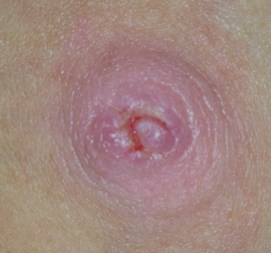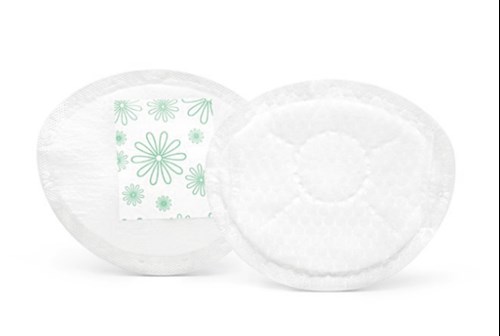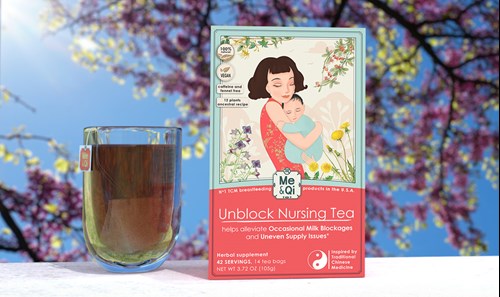Contents
- What Are The Signs And Symptoms Of Cracked Or Chapped Nipples?
- Are There Early Signs That The Nipples May Become Chapped Later?
- Why Are Nipples Chapped or Cracked?
- Is It Safe To Continue Breastfeeding With A Chapped Nipple?
- How Long Do Chapped Nipples Last?
- How To Heal Chapped Nipples? What Are The Home Remedies?
- Why Are The Nipple Chapped Or Cracked For Non-Pregnant Women?
- Why Are The Nipple Chapped Or Cracked During Pregnancy?
What Are The Signs And Symptoms Of Cracked Or Chapped Nipples?
For breastfeeding mothers, chapped or cracked nipples may show the following characteristics

- Split Nipple
They may have cuts on the nipple with blood or sticky pus discharge.
- Sharp and Shooting Pain
The area around the cracks may feel uncomfortable or even excruciatingly painful. The mother may experiences burning, sharp, and shooting pain during and after breastfeeding.
- Peeling Or Crusting
Cracks might peel or become crusted over. Nipple skin appears red or brown, irritated, itchy, and scabbed.
Are There Early Signs That The Nipples May Become Chapped Later?
- The nipples appear flattened, wedge-shaped, and white due to poor latching technique, especially in the beginning of breastfeeding.
- Breast blebs or blisters: They appear when nipple pores become clogged by a piece of skin or a tiny portion of solidified breast milk. When these blebs or blisters break, they can cause fissures on the nipples.
- Clogged Milk Ducts: It happens when the milk doesn’t flow and accumulates in the milk ducts. Thus, the baby needs to make extra effort to suck in order to get enough food. This excessive pressure can result in chapped nipples.
Why Are Nipples Chapped or Cracked?
One of the main causes of chapped nipples is breastfeeding. Most women are surprised to discover that breastfeeding, which feels so natural, is often a challenging task.
Another important cause is the sensitivity of the nipple skin. They are not accustomed to the level of stimulation and abrasion during in early breastfeeding. Detailed explanation are:
1. Improper Positioning while Breastfeeding
Most mothers complain about chapped nipples within the first month of giving birth. As they are new to the task, it is quite common to get cracked nipples due to poor latching techniques and unsuitable positionings.
For example, In the early stages, it might be difficult for the mother to properly position the baby’s mouth towards the nipple.
2. Poor Latching Techniques
Latching requires practice as well. For a good latching, the baby needs to open the mouth widely and hold the nipple and areola as deep as possible to squeeze the milk out of the ducts and nipple pores.
If the baby only latches on the nipple, the milk ducts cannot be pressed enough. As a result, the baby needs to suck harder to get enough milk. This excessive suckling pressure may cause nipple cracks or cuts.
3. Tight bra
If a bra is too tight, it can cause excessive pressure on your nipples and lead to chapped and irritated nipples. A loose bra can also rub against the sensitive nipple skin and causes cracks.
4. Breast Infections
Breast Infections are not uncommon among breastfeeding women. Bacteria can get transmitted from the infant's mouth and nose to the mother's breasts. As the skin there is very sensitive, breast infections lead to chapped nipples and fissures.
5. Breast Eczema
Breast eczema, also known as atopic dermatitis, is a skin condition with rash, dryness, scaling, itchiness, and splits on the nipples, areolas, or whole breasts. The nipple cracks may bleed, become infected, and start oozing.
Is It Safe To Continue Breastfeeding With A Chapped Nipple?
Yes, you can continue breastfeeding even though one or two of the nipples are chapped. It is generally safe even if some blood or even nipple discharge goes to the baby's mouth.
However, if it is very painful, the mother can use a pumping machine or hand expression to extract milk for 1 or 2 days. The nipple cracks can heal during this time.
How Long Do Chapped Nipples Last?
The healing time for a chapped nipple depends on the severity of the cracks. They mostly heal within a day or two, but if the crack is deep or the healing is compromised, it could take two to three weeks to fully recover. The healing time also largely depends upon whether some of the below home remedies are applied or not.
How To Heal Chapped Nipples? What Are The Home Remedies?
The treatments for chapped nipples can begin at home. They cover three major categories:
1. Better Breastfeeding Techniques and Habits
- Proper Latching And Feeding Position
Cracked nipple treatment depends on the baby's positioning and proper latching. Since this is a learning process, making mistakes over the first few days of giving birth is rather common. When holding a newborn, you should make sure that the baby is near your body and that the hip, ear, and shoulder are properly aligned.
Follow these tips to ensure proper latching:
-
- Find a comfortable sitting position and support yourself with pillows.
- Make sure that the baby is held "belly to belly" so that he/she does not have to turn head to reach the mother's breast.
- His/her nose should come very close to touching the mother's breasts.
- To open the baby's mouth, gently rub the nipple back and forth to get the milk flowing. The smell of the milk drops will attract the baby to open his/her mouth.
- Theoretically, there should not be any pain in either the nipple or the breast. If, indeed, there is pain, you can break the seal by placing a finger on the inside corner of the baby's lips, so that the suckling pressure is reduced.
- To ensure sufficient pressure over milk ducts, it’s important that the baby’s mouth should not only cover the nipples but also cover as much areola as possible.
- Frequent Breast Emptying
The mother needs to empty the breasts frequently and evenly to avoid breast engorgement and clogged ducts, which makes latching more difficult. This will increase the pressure on the nipples and worsen the fissures.
- Use A Pumping Machine
There are two advantages of using a pumping machine. First of all, it avoids direct contact between the chapped nipple and the baby's mouth. Thus, it reduces the risk of bacteria exchange between the mother and the baby.
Secondly, the machine's suction power is controllable. Try lower degrees to avoid further irritation on nipple cracks.
2. Keep The Breasts Clean, Away From Potential Bacteria
- Wear The Right Bra
When it comes to the bra that you wear, be sure that it is neither overly tight nor too rough. You should be as gentle as possible when dealing with your nipples!
One additional thing you can do for your cracked nipples is to completely clean your bras after washing them. Why? Any residue of detergent could make your skin itchy.
Currently, some specifically made nursing bras are also available such as a seamless bra. They are made up of stretchable synthetic material to accommodate breast size fluctuations and are easy to unclip.

- Regularly Change Your Nursing Pads
When shopping for nursing pads, look for ones made of cotton that are either soft or disposable. Then make sure that you frequently change them to keep breast areas dry. Prolonged use of wet nursing pads might aggravate nipple irritation and increase the chance of developing breast infection.
- Use Epsom Salt Water and Air Out
Clean the breasts after each feeding with Epsom salty water and leave your breasts dry. Salt is antibacterial, as it sucks water out of the bacteria and kills them. In addition to this feature, salt water aids in nipple cuts healing and reduces swelling.
If possible, give your breasts some time to air out before wearing your bra again.
- Silverette Nursing Cups
You can also try silverette nursing cups. It is said to reduce pressure on the chapped nipples and kinds of providing a hygienic space against bacteria.
3. Healing of Nipple Cracks and Treating Underlying Infections
- Treat Underlying Breast Infections

As mentioned earlier, the bacteria can easily get transmitted from the infant's mouth and nose to the mother's breasts and nipples. Antibiotic is often used to treat the infection. However, medicine is not a natural option, and it also requires a doctor's prescription.
You can also try Unblock Nursing Tea, which is a natural herb formula specialized in removing toxin Heat. According to Traditional Chines Medicine (TCM), the toxin Heat is the phenomenon of bacterial transmission from the baby’s mouth to the mother during breastfeeding.
It contains cooling herbs (eg: Platycodon and Dong Quai, Chrysanthemum flowers, Dandelions, and Honeysuckle flowers)that eliminate infection and heal fissures.
- Use Nipple Shields During Breastfeeding and Apply Cracked Nipple Cream Afterwards
During breastfeeding, you can use a nipple shield to avoid direct contact between the nipple cracks and the baby's mouth to reduce pain and further skin irritation.
After feeding, you can apply cracked nipple creams or ointment (eg: topical lanolin) to prevent bacterial transmission. It also helps the skin to heal faster.
Why Are The Nipple Chapped Or Cracked For Non-Pregnant Women?
When it comes to chapped and dry nipples, it is often linked to breastfeeding mothers. However, it could a problem for non-pregnant women as well.
For example, lotions, detergents, soaps, and fabrics can irritate the breast's skin and cause eczema, which may lead to nipple fissures as a result. In most cases, eczema only heals once the source of the allergy is found and removed.
In non-pregnant women, chapped nipples can be caused by friction like when you wear a sports bra that doesn't fit right and the breast cloth rubs against the skin.
Furthermore, nipples can also become chapped due to Paget's disease. This is a type of breast cancer that affects the nipple skin and results in itchy, cracked nipples with bloody or yellow discharge.
Why Are The Nipple Chapped Or Cracked During Pregnancy?
During pregnancy, the nipples may become painful, sore, and dry. The hormonal variations cause a woman's nipples to become dry or sensitive. As estrogen and progesterone levels fluctuate, the breasts undergo many changes, including enlargement. This extra weight can cause the tissue in your nipple to stretch and then crack.

